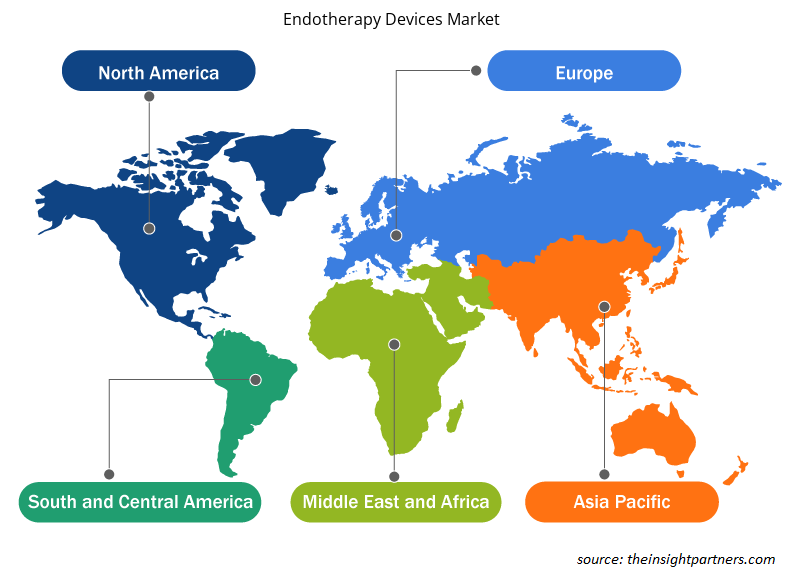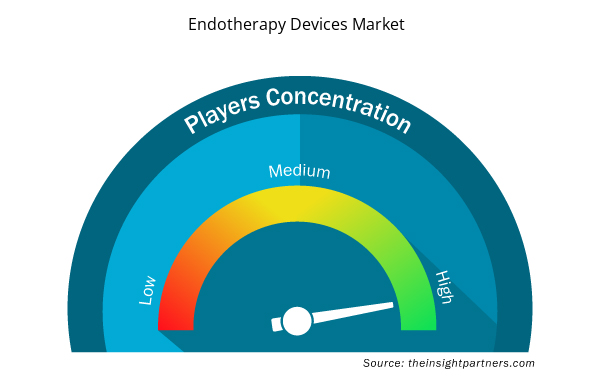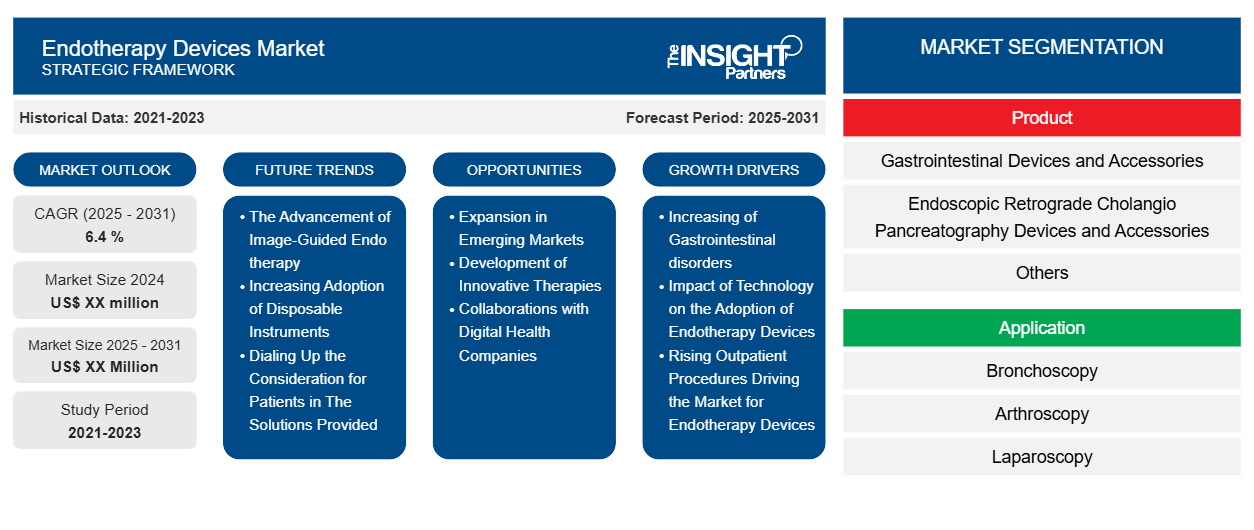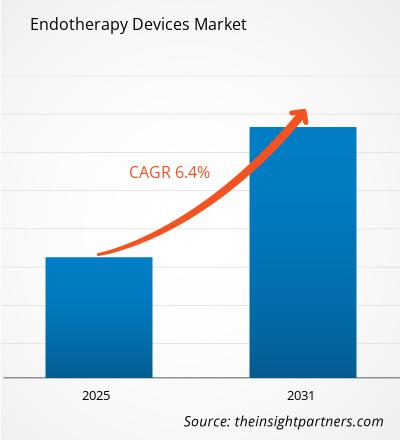内視鏡治療装置市場は、2023年から2031年にかけて6.4%のCAGRを記録し、市場規模は2023年のXX百万米ドルから2031年にはXX百万米ドルに拡大すると予想されています。
レポートは、製品(消化器デバイスと付属品、内視鏡的逆行性胆道膵管造影デバイスと付属品、その他)ごとにセグメント化されています。さらに、レポートはアプリケーション(気管支鏡検査、関節鏡検査、腹腔鏡検査、泌尿器内視鏡検査、神経内視鏡検査、消化器内視鏡検査、その他)に基づいてセグメント化されています。また、レポートはエンドユーザー(病院、診療所、その他)に基づいてセグメント化されています。グローバル分析は、地域レベルと主要国でさらに細分化されています。レポートは、上記の分析とセグメントの値をUSDで提供しています。
報告書の目的
The Insight Partners のレポート「内視鏡治療装置市場」は、現在の状況と将来の成長、主な推進要因、課題、機会を説明することを目的としています。これにより、次のようなさまざまなビジネス関係者に洞察が提供されます。
- テクノロジープロバイダー/メーカー: 進化する市場の動向を理解し、潜在的な成長機会を把握することで、情報に基づいた戦略的意思決定が可能になります。
- 投資家: 市場の成長率、市場の財務予測、バリュー チェーン全体に存在する機会に関する包括的な傾向分析を実施します。
- 規制機関: 市場の濫用を最小限に抑え、投資家の信用と信頼を維持し、市場の完全性と安定性を維持することを目的として、市場における政策と警察活動を規制します。
内視鏡治療機器市場のセグメンテーション
製品
- 消化器系機器および付属品
- 内視鏡的逆行性胆道膵管造影装置および付属品
- その他
応用
- 気管支鏡検査
- 関節鏡検査
- 腹腔鏡検査
- 泌尿器科内視鏡検査
- 神経内視鏡検査
- 消化管内視鏡検査
- 他の
エンドユーザー
- 病院
- クリニック
- その他
地理
- 北米
- ヨーロッパ
- アジア太平洋
- 南米と中央アメリカ
- 中東およびアフリカ
地理
- 北米
- ヨーロッパ
- アジア太平洋
- 南米と中央アメリカ
- 中東およびアフリカ
要件に合わせてレポートをカスタマイズする
このレポートの一部、国レベルの分析、Excelデータパックなど、あらゆるレポートを無料でカスタマイズできます。また、スタートアップや大学向けのお得なオファーや割引もご利用いただけます。
- このレポートの主要な市場動向を入手してください。この無料サンプルには、市場動向から見積もりや予測に至るまでのデータ分析が含まれます。
内視鏡治療機器市場の成長要因
- 胃腸疾患の増加: 炎症性腸疾患や大腸がんなどの胃腸疾患が増加しており、これが内視鏡治療機器市場の成長を促進する主な要因の 1 つです。すべての病気と同様に、治療が困難な場合、すべての患者が群がるわけではないにしても、低侵襲性の治療に対する需要が高まります。内視鏡装置は診断および治療手段を提供するため、患者の治療結果を向上させたい医療従事者の間で人気が高まっています。
- 内視鏡治療装置の採用に対する技術の影響: より侵襲性の低い治療法における技術の進化は、内視鏡治療装置市場の成長を促している主な要因の 1 つです。高度な画像処理手順や手術を支援するロボット システムなどの新しい技術により、内視鏡検査はより侵襲性が低く、より安全になりました。このような技術は、医療従事者だけでなく、より負担の少ない処置を受けたい患者にとっても喜ばしいものであり、内視鏡治療装置の使用が増加し、市場の範囲が拡大しています。
- 外来処置の増加が内視鏡治療機器市場を牽引: 内視鏡治療機器市場は、外来処置を受ける患者数の急増によっても大きく成長しています。一般の人々は、医療センターでの滞在期間を最短にし、より早く帰宅できる治療法を選択する傾向があります。このような治療を容易にする内視鏡治療機器は、効果的な外来治療戦略を強化し、医療システムへの応用を促進し、患者支援の変化するシナリオの中で市場を改善します。
内視鏡治療機器市場の将来動向
- 画像誘導内視鏡治療の進歩: 内視鏡治療装置と組み合わせた画像技術の使用は、診断と治療介入の両方の精度を大幅に向上させる新たなトレンドです。高解像度内視鏡とリアルタイム画像により、病変やその他の異常の視覚化が向上しました。そのため、この機能強化により臨床結果が向上し、医療従事者がより集中した治療を提供することを目指すにつれて内視鏡治療装置の需要が高まります。
- 使い捨て器具の採用増加: 感染管理と安全への懸念が高まったため、使い捨ての内視鏡治療器具を使用するという新しいアプローチが生まれています。使い捨ての単回使用アイテムを使用すると、交差汚染のリスクが制限され、器具の徹底的な洗浄が不要になります。ほとんどの医療施設は患者の安全を確保することを目指しており、この傾向は使い捨て機器の市場を生み出すだけでなく、内視鏡治療機器のデザインと素材の創造的な進歩にもつながります。
- 提供されるソリューションにおける患者への配慮の強化: 内視鏡治療機器市場では、患者のニーズが最優先事項となり、患者の体験を向上させる内視鏡治療機器の導入につながっています。製造される機器の目的は、人に優しく、患者の痛みが少なく、患者の期待に応えられることです。よりシンプルな設計でありながら生産性の高い結果を求めるこの姿勢が、市場の拡大を後押ししています。医療提供者も、手順の効率化を通じて患者の満足度を向上させたいと考えているため、さらにその傾向が強まっています。
内視鏡治療機器の市場機会
- 新興市場での拡大: 医療インフラが整備されつつある新興市場では、内視鏡治療機器市場が著しく成長する可能性がある。おそらく、先進医療技術や質の高い医療へのアクセスに対する認識が高まるにつれ、内視鏡治療機器の需要は上昇傾向にある。企業は、こうした地域向けに製品をカスタマイズし、医療システムと提携することで、この傾向を活用できる。
- 革新的な治療法の開発: 内視鏡治療装置を組み込み、生物学的製剤の開発や合理的に設計された治療法などのさまざまなアプローチを活用することで、新しい治療法を生み出すことができます。このような組み合わせにより、メーカーはあらゆる種類の胃腸疾患の治療を最適化する革新的な完全なソリューションを開発できるようになります。また、内視鏡治療装置の適応症の範囲が拡大し、医療科学を進歩させる企業も登場しています。
- デジタル ヘルス企業とのコラボレーション: デジタル ヘルスに携わる企業とのコラボレーションは、内視鏡治療機器市場で考慮すべき機会です。たとえば、内視鏡治療ソリューションに遠隔医療ツールや患者モニタリング アプリケーションを追加すると、患者の管理とフォローアップを強化できます。これにより、患者の治療管理エクスペリエンスが向上し、その逆も同様です。これには、技術に起因する直線的な市場の成長と有用性が含まれます。このような患者には、業界の進歩に役立つ情報を提供する研究が含まれます。
内視鏡治療機器市場の地域別分析
予測期間を通じて内視鏡治療装置市場に影響を与える地域的な傾向と要因は、Insight Partners のアナリストによって徹底的に説明されています。このセクションでは、北米、ヨーロッパ、アジア太平洋、中東、アフリカ、南米、中米にわたる内視鏡治療装置市場のセグメントと地理についても説明します。

- 内視鏡治療機器市場の地域別データを入手
内視鏡治療機器市場レポートの範囲
| レポート属性 | 詳細 |
|---|---|
| 2023年の市場規模 | XX百万米ドル |
| 2031年までの市場規模 | XX百万米ドル |
| 世界のCAGR(2023年~2031年) | 6.4 % |
| 履歴データ | 2021-2022 |
| 予測期間 | 2024-2031 |
| 対象セグメント | 製品別
|
| 対象地域と国 | 北米
|
| 市場リーダーと主要企業プロフィール |
|
内視鏡治療機器市場のプレーヤー密度:ビジネスダイナミクスへの影響を理解する
エンドセラピー機器市場は、消費者の嗜好の変化、技術の進歩、製品の利点に対する認識の高まりなどの要因により、エンドユーザーの需要が高まり、急速に成長しています。需要が高まるにつれて、企業は提供品を拡大し、消費者のニーズを満たすために革新し、新たなトレンドを活用し、市場の成長をさらに促進しています。
市場プレーヤー密度とは、特定の市場または業界内で活動している企業または会社の分布を指します。これは、特定の市場スペースに、その規模または総市場価値と比較して、どれだけの競合相手 (市場プレーヤー) が存在するかを示します。
内視鏡治療装置市場で事業を展開している主要企業は次のとおりです。
- ストライカーコーポレーション
- メドトロニック
- オリンパス株式会社
- HOYA株式会社
- 富士フイルムホールディングス株式会社
免責事項:上記の企業は、特定の順序でランク付けされていません。

- 内視鏡治療機器市場のトップキープレーヤーの概要を入手
主なセールスポイント
- 包括的なカバレッジ: レポートでは、内視鏡治療装置市場の製品、サービス、タイプ、エンドユーザーの分析を包括的にカバーし、全体的な展望を提供します。
- 専門家による分析: レポートは、業界の専門家とアナリストの深い理解に基づいてまとめられています。
- 最新情報: このレポートは、最新の情報とデータの傾向を網羅しているため、ビジネスの関連性を保証します。
- カスタマイズ オプション: このレポートは、特定のクライアント要件に対応し、ビジネス戦略に適切に適合するようにカスタマイズできます。
したがって、内視鏡治療装置市場に関する調査レポートは、業界のシナリオと成長の見通しを解読し理解する道の先導役となる可能性があります。いくつかの正当な懸念があるかもしれませんが、このレポートの全体的な利点は欠点を上回る傾向があります。
- 過去2年間の分析、基準年、CAGRによる予測(7年間)
- PEST分析とSWOT分析
- 市場規模価値/数量 - 世界、地域、国
- 業界と競争環境
- Excel データセット


- Single Pair Ethernet Market
- Resistance Bands Market
- Social Employee Recognition System Market
- Skin Graft Market
- Blood Collection Devices Market
- Piling Machines Market
- Medical Audiometer Devices Market
- Hair Extensions Market
- Health Economics and Outcome Research (HEOR) Services Market
- Biopharmaceutical Contract Manufacturing Market

Report Coverage
Revenue forecast, Company Analysis, Industry landscape, Growth factors, and Trends

Segment Covered
This text is related
to segments covered.

Regional Scope
North America, Europe, Asia Pacific, Middle East & Africa, South & Central America

Country Scope
This text is related
to country scope.
よくある質問
Stryker Corporation,
, Medtronic Plc.,
, Olympus Corporation are the key players operating in the endotherapy devices market
2021 to 2022- are the historic year, 2023 - base year, 2024 to 2031- are the forecast year
The report can be delivered in PDF/Word format, we can also share excel data sheet based on request.
Gastrointestinal Devices and Accessories segment
accounts for highest revenue in product type in the market in 2023
Based on geography, Asia Pacific held the largest share of the endotherapy devices market.
The Endotherapy Devices Market is estimated to witness a CAGR of 6.4 % from 2023 to 2031
Trends and growth analysis reports related to Life Sciences : READ MORE..
The List of Companies
- Stryker Corporation
- Medtronic Plc.
- Olympus Corporation
- HOYA Corporation
- FUJIFILM Holdings Corporation
- CONMED Corporation
- Boston Scientific Corporation
- Smith & Nephew Plc.
- KARL STORZ GmbH & Co KG
- Johnson & Johnson
The Insight Partners performs research in 4 major stages: Data Collection & Secondary Research, Primary Research, Data Analysis and Data Triangulation & Final Review.
- Data Collection and Secondary Research:
As a market research and consulting firm operating from a decade, we have published and advised several client across the globe. First step for any study will start with an assessment of currently available data and insights from existing reports. Further, historical and current market information is collected from Investor Presentations, Annual Reports, SEC Filings, etc., and other information related to company’s performance and market positioning are gathered from Paid Databases (Factiva, Hoovers, and Reuters) and various other publications available in public domain.
Several associations trade associates, technical forums, institutes, societies and organization are accessed to gain technical as well as market related insights through their publications such as research papers, blogs and press releases related to the studies are referred to get cues about the market. Further, white papers, journals, magazines, and other news articles published in last 3 years are scrutinized and analyzed to understand the current market trends.
- Primary Research:
The primarily interview analysis comprise of data obtained from industry participants interview and answers to survey questions gathered by in-house primary team.
For primary research, interviews are conducted with industry experts/CEOs/Marketing Managers/VPs/Subject Matter Experts from both demand and supply side to get a 360-degree view of the market. The primary team conducts several interviews based on the complexity of the markets to understand the various market trends and dynamics which makes research more credible and precise.
A typical research interview fulfils the following functions:
- Provides first-hand information on the market size, market trends, growth trends, competitive landscape, and outlook
- Validates and strengthens in-house secondary research findings
- Develops the analysis team’s expertise and market understanding
Primary research involves email interactions and telephone interviews for each market, category, segment, and sub-segment across geographies. The participants who typically take part in such a process include, but are not limited to:
- Industry participants: VPs, business development managers, market intelligence managers and national sales managers
- Outside experts: Valuation experts, research analysts and key opinion leaders specializing in the electronics and semiconductor industry.
Below is the breakup of our primary respondents by company, designation, and region:

Once we receive the confirmation from primary research sources or primary respondents, we finalize the base year market estimation and forecast the data as per the macroeconomic and microeconomic factors assessed during data collection.
- Data Analysis:
Once data is validated through both secondary as well as primary respondents, we finalize the market estimations by hypothesis formulation and factor analysis at regional and country level.
- Macro-Economic Factor Analysis:
We analyse macroeconomic indicators such the gross domestic product (GDP), increase in the demand for goods and services across industries, technological advancement, regional economic growth, governmental policies, the influence of COVID-19, PEST analysis, and other aspects. This analysis aids in setting benchmarks for various nations/regions and approximating market splits. Additionally, the general trend of the aforementioned components aid in determining the market's development possibilities.
- Country Level Data:
Various factors that are especially aligned to the country are taken into account to determine the market size for a certain area and country, including the presence of vendors, such as headquarters and offices, the country's GDP, demand patterns, and industry growth. To comprehend the market dynamics for the nation, a number of growth variables, inhibitors, application areas, and current market trends are researched. The aforementioned elements aid in determining the country's overall market's growth potential.
- Company Profile:
The “Table of Contents” is formulated by listing and analyzing more than 25 - 30 companies operating in the market ecosystem across geographies. However, we profile only 10 companies as a standard practice in our syndicate reports. These 10 companies comprise leading, emerging, and regional players. Nonetheless, our analysis is not restricted to the 10 listed companies, we also analyze other companies present in the market to develop a holistic view and understand the prevailing trends. The “Company Profiles” section in the report covers key facts, business description, products & services, financial information, SWOT analysis, and key developments. The financial information presented is extracted from the annual reports and official documents of the publicly listed companies. Upon collecting the information for the sections of respective companies, we verify them via various primary sources and then compile the data in respective company profiles. The company level information helps us in deriving the base number as well as in forecasting the market size.
- Developing Base Number:
Aggregation of sales statistics (2020-2022) and macro-economic factor, and other secondary and primary research insights are utilized to arrive at base number and related market shares for 2022. The data gaps are identified in this step and relevant market data is analyzed, collected from paid primary interviews or databases. On finalizing the base year market size, forecasts are developed on the basis of macro-economic, industry and market growth factors and company level analysis.
- Data Triangulation and Final Review:
The market findings and base year market size calculations are validated from supply as well as demand side. Demand side validations are based on macro-economic factor analysis and benchmarks for respective regions and countries. In case of supply side validations, revenues of major companies are estimated (in case not available) based on industry benchmark, approximate number of employees, product portfolio, and primary interviews revenues are gathered. Further revenue from target product/service segment is assessed to avoid overshooting of market statistics. In case of heavy deviations between supply and demand side values, all thes steps are repeated to achieve synchronization.
We follow an iterative model, wherein we share our research findings with Subject Matter Experts (SME’s) and Key Opinion Leaders (KOLs) until consensus view of the market is not formulated – this model negates any drastic deviation in the opinions of experts. Only validated and universally acceptable research findings are quoted in our reports.
We have important check points that we use to validate our research findings – which we call – data triangulation, where we validate the information, we generate from secondary sources with primary interviews and then we re-validate with our internal data bases and Subject matter experts. This comprehensive model enables us to deliver high quality, reliable data in shortest possible time.


 このレポートの無料サンプルを入手する
このレポートの無料サンプルを入手する